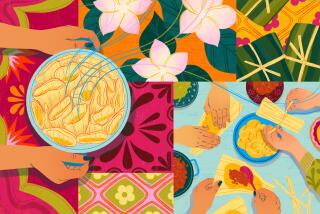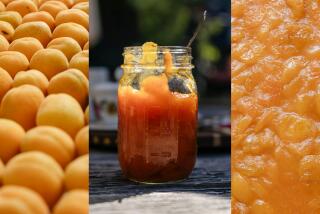All-Purpose Tonic : Jamu: It’s a Way of Life in Indonesia
- Share via
JAKARTA, Indonesia — Nani knelt beside her basket, popped the cork on an old Johnnie Walker bottle and sloshed the creamy contents into a tall glass.
Her customer, a first-timer, gave a go-ahead nod, and she poured in some of the brown stuff; a splash of the clear; slugs from two or three other bottles; an egg yolk, and a packet of the secret powder.
Take it like a man, the Indonesians say--standing, “so the stomach opens up,” and down the hatch. Hahh! The afterburner kicks in as the liquid passes the lips. Achh! A bitter collar wraps the throat. Whew! It’s down, and a honey chaser spreads relief.
Good morning, Jakarta! It’s jamu time.
Peddled for Generations
Generations before health-food stores anchored every Southern California mini-mall, Nani’s forebears were concocting and peddling jamu in Java, the island heart of Indonesia.
Roots and leaves, bark and tubers, jamu is usually described by what it does, not what, specifically, it is.
Nani had suggested a jamu to “lose weight and be sexy,” but on checking her bottles and powders she discovered that, at 8:30 on her morning rounds of the sidewalks of Jakarta’s Pasar Gambira district, it was already sold out.
At the jamu counter of the big Sarinah Department Store, saleswomen proffer buyers a variety of take-home packets: Darsalin for slimming, Busterin for developing breasts, compounds to treat hemorrhoids and dysentery and herbal tea mixes that look like the sweepings off a forest floor. Many carry the legend: “The main thing is to promote husband and wife happiness.”
It Defies Definition
What is jamu ? From herbal teas and cosmetics to the packaged powders--”add water and stir”--that make up 70% of the market, the word defies definition. Sudarmilah Suparto, a manufacturer, wrote: “Many doctors in the Department of Health say that jamu is traditional medicine. But that’s really incorrect . . . because up to now we are not yet ready to say jamu is a medicine. Jamu is jamu. “
“Jamu is a way of life,” ventured Charles Ong, the American-educated marketing director for Nonya Meneer, Indonesia’s biggest jamu manufacturer. “If I do not take it, I cannot work. I do all the wrong things.”
The company is named for his late grandmother, who reputedly was the first to commercialize jamu. The small factory she established in 1919 in the coastal city of Semarang has grown to a $40-million-a-year business producing 200 varieties of pills, tablets, powders and herbal-based skin treatments.
The very model of a modern market researcher, Ong commissions surveys of his consumers. “Our market is upper middle income,” he said, and Nonya Meneer is spending $4 million a year on advertising and promotion to increase its share. Reaching out to the younger generation, an Indonesian pop idol spreads the company message on radio ads, a light jazz jingle promoting what Ong calls “products for inner beauty.”
Already exporting to Europe, Southeast Asia and Saudi Arabia, Ong has his eyes on the American market.
“California is my first target,” the marketing director confided. “A mixture of people, Asian people. I think it would be easier for me to get in. Maybe in two or three years.”
Another prominent producer, Mooryati Soedibyo, president of Mustika Ratu and head of the Jamu Businessmen’s Assn., is a personal advertisement for her products. “I’m not sweet 16, but sweet 60,” Soedibyo admits, though she looks 20 years younger.
Mustika Ratu, a late starter in the industry, has moved into glamour, internally and externally applied. Eye liner, for instance, made in part from burnt coconut and cloves. Soedibyo’s products have found a corner of the Japanese cosmetics market.
What is now a modern industry began in the royal courts of central Java, in the city of Solo. Soedibyo is a link to those days.
Her childhood was spent in the court of her grandfather, Sultan Pakubuwono X, a privileged life hidden from the common people.
Royal Lessons
“I learned the way of the kraton (court),” she said. “I was taught the dance for fitness, how to make batik cloth, to play the instruments of the gamelan,” the soft rhythms that Indonesians call “the sound of moonlight.”
Most importantly, “we were taught to take care of the body,” for the villagers expected their royals to be models of beauty and took pride in them.
The secret, Soedibyo said, lay in jamu, and court recipes were closely guarded. If, as Ong says, jamu is a way of life, it is entwined with the cycles of womanhood. “When I was a child,” Soedibyo explained, “I took jamu regularly, especially after my first monthly period.”
Special recipes were ingested or applied before and after childbirth, to promote a safe pregnancy and smooth the skin after delivery. The wedding day was an occasion for secret potions, scents and shampoos.
Secrets Gradually Spread
Secrets like these could not be hidden behind the palace walls forever. The villagers used a simple jamu, maybe three or four ingredients. Palace recipes were made up of many more, some of them exotic imports from outlying islands, China and India. Most manufacturers now assert that their products are derived from “court recipes,” presumably slipped past the walls by palace cooks or maids.
They are sold in department stores, small kiosks and apotiks --Indonesian drugstores. And they are peddled by “ jamu ladies” like Nani.
Ong, the Nonya Meneer executive, estimates that there are more than 5,000 jamu sellers on the streets of Jakarta. Most are from Solo. They carry their bottled concoctions in a basket slung across their backs in a sarong cloth, calling out “Jamu, jamu!” as they make their rounds.
Many live near the Jakarta railway station, where they can buy fresh herbs at the open market. They are organized, each with certain exclusive streets and some areas shared in common.
The Jamu Lady’s Outfit
Mbasri, wearing the traditional jamu lady’s outfit of a batik sarong and a fitted top, carried nine bottles in her basket. (The odd number indicates that she is single, according to Ong). She stopped at an apartment building to prepare tonics for her regulars, an appetite enhancer for a 5-year-old boy and a concoction for “women’s health” for another buyer.
Her day begins at 4 a.m., grinding herbs, mashing roots and mixing her potions. By daybreak, she’s selling. At 300 rupiah a glass, about 17 cents, it’s a modest living, and hard work; the basket, with bottles full, weighs more than 30 pounds. But she leaves her customers smiling, or gasping.
Ees, a bare-chested, tattooed, 38-year-old pedicab driver, says he takes a morning potion for strength. A woman, he added, drinks jamu “to make her beautiful when she goes to bed.”
In Asia, where most men and some women search endlessly for potions to stimulate their libido, every country has an array of reputed aphrodisiacs. Does jamu serve that purpose?
If it does, suggested Dr. Sardjono Santoso, head of the department of pharmacology at the University of Indonesia, “it’s a subjective feeling.”
Isabella Linser, an Austrian botanist who is making an empirical study of the uses and effects of jamu, finds the work hard going. For Chinese herbal medicine, she explained, “we have records, very scholarly,” of medicinal plants and their effects. “None of these things exist in Indonesia.”
Simplistically, Linser said, traditional jamu is applied under a concept similar to the Chinese yin and yang , forces that must be kept in balance.
Heats Up, Cools Off
“If a woman cannot have children, they say it is because she is too hot, not just in body temperature but in some mystical way,” the botanist explained. “They give her a cooling tonic,” perhaps a potion based on the turmeric root. If the diagnosis is “too cool,” the prescribed jamu will usually include ginger and pepper. As a morning tonic, men usually take the ginger and the women the turmeric.
“I’m interested in the efficacy of jamus ,” said Santoso, the University of Indonesia pharmacologist, who has studied the active ingredients in the products.
Research by other scientists, he said, has turned up the presence of dangerous levels of toxins and bacteria in some packaged jamus, though not in the products of the major companies. As a member of the board of traditional drug registration for the Department of Health, Santoso says his work is hampered by what he calls the understandable secrecy of commercial producers.
“They will disclose the ingredients, but not the formulas,” he noted. Furthermore, Santoso insisted, not enough research has been done on the possible side effects of the products.
But the doctor argues that with proper controls, jamu is a valuable and necessary business in his country. Traditional treatments are a first line of medicinal defense in an archipelago of 13,000 islands and remote villages. And jamu can be an important export for a country whose foreign earnings have fallen in recent years with the price of oil.
More to Read
Eat your way across L.A.
Get our weekly Tasting Notes newsletter for reviews, news and more.
You may occasionally receive promotional content from the Los Angeles Times.










